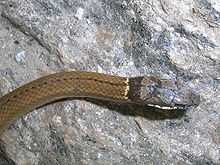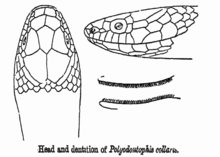Sibynophis collaris
| Sibynophis collaris | |
|---|---|
 | |
| Conservation status | |
| Scientific classification | |
| Kingdom: | Animalia |
| Phylum: | Chordata |
| Subphylum: | Vertebrata |
| Class: | Reptilia |
| Order: | Squamata |
| Suborder: | Serpentes |
| Family: | Colubridae |
| Subfamily: | Colubrinae |
| Genus: | Sibynophis |
| Species: | S. collaris |
| Binomial name | |
| Sibynophis collaris (Gray, 1853) | |
| Synonyms | |
Sibynophis collaris, commonly known as the common many-toothed snake or the collared black-headed snake,[4] is a species of colubrid snake endemic to South Asia.
Description

Rostral scale twice as broad as deep, just visible from above; suture between the internasals shorter than that between the prefrontals; frontal longer than its distance from the end of the snout, as long as the parietals or shorter; loreal as long as or a little longer than deep; one preocular; two postoculars, only the upper in contact with the parietal; temporals 1 (or 2) + 2; 9 or 10 upper labials, fourth, fifth, and sixth entering the eye; 4 lower labials in contact with the anterior chin shields, which are as long as the posterior chin shields.
Dorsal scales smooth, without apical pits, in 17 rows. Ventrals 159-190; anal divided; subcaudals divided, 102-131.
Brown above, vertebral region greyish, usually with a series of small round black spots; head with small black spots or vermiculations above, and two black crossbands, one across the posterior part of the frontal and supraoculars, the other across the occiput; a large black nuchal spot or crossband, bordered with yellow posteriorly; a black line from the nostril to the nuchal spot, passing through the eye, bordering the white black-dotted upper lip. Lower parts yellowish, each ventral with an outer black spot or streak, which may be confluent on the posterior part of the body; anterior ventrals with a pair of median dots in addition.
Total length 29 inches (737 mm); tail 9.5 inches (241 mm).[5]
Distribution
Sub-Himalayan India (Assam, Simla), Mizoram, Nepal, Myanmar (Burma), Thailand, Laos, Vietnam, Cambodia, West Malaysia, China (SE Tibet and Yunnan), Taiwan and island of Jeju in South Korea (Type locality:Khasi Hills, India)
Notes
- ↑ Bain, R.H. (2010). "Sibynophis collaris". IUCN Red List of Threatened Species. Version 2012.2. International Union for Conservation of Nature. Retrieved 28 October 2012.
- ↑ Boulenger, G.A. 1893. Catalogue of the Snakes in the British Museum (Natural History). Volume I., Containing the Families...Colubridæ Aglyphæ, Part. Trustees of the British Museum (Natural History). London. xiii + 440 pp. + Plates I.-XXVIII. (Polyodontophis collaris, pp. 184-185 & Plate XII, Figures 1., 1a., 1b., & 1c.)
- ↑ The Reptile Database. www.reptile-database.org
- ↑ Das, Indraneil. 2002. A Photographic guide to Snakes and Other Reptiles of India. Ralph Curtis Bokks. Sanibel Island, Florida. 144 pp. ISBN 0-88359-056-5 (Sibynophis collaris, p. 45.)
- ↑ Boulenger, G.A. 1890. The Fauna of British India, Including Ceylon and Burma. Reptilia and Batrachia. Secretary of State for India in Council. (Taylor and Francis, Printers). London. 541 pp. (Polyodontophis collaris, pp. 301-303.)
Further reading
- Gray, J.E. 1853. Descriptions of some undescribed species of Reptiles collected by Dr. Joseph Hooker in the Khassia Mountains, East Bengal, and Sikkim Himalaya. Ann. Mag. Nat. Hist. (2) 12: 386 - 392. (Psammophis collaris, p. 390.)
